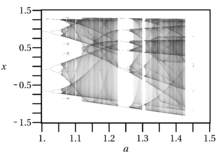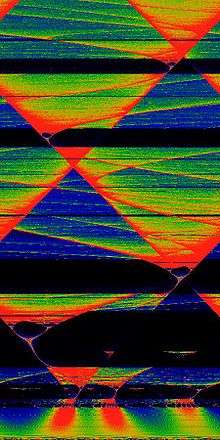Hénon map


The Hénon map is a discrete-time dynamical system. It is one of the most studied examples of dynamical systems that exhibit chaotic behavior. The Hénon map takes a point (xn, yn) in the plane and maps it to a new point
The map depends on two parameters, a and b, which for the classical Hénon map have values of a = 1.4 and b = 0.3. For the classical values the Hénon map is chaotic. For other values of a and b the map may be chaotic, intermittent, or converge to a periodic orbit. An overview of the type of behavior of the map at different parameter values may be obtained from its orbit diagram.
The map was introduced by Michel Hénon as a simplified model of the Poincaré section of the Lorenz model. For the classical map, an initial point of the plane will either approach a set of points known as the Hénon strange attractor, or diverge to infinity. The Hénon attractor is a fractal, smooth in one direction and a Cantor set in another. Numerical estimates yield a correlation dimension of 1.25 ± 0.02[1] and a Hausdorff dimension of 1.261 ± 0.003[2] for the attractor of the classical map.
Attractor

The Hénon map maps two points into themselves: these are the invariant points. For the classical values of a and b of the Hénon map, one of these points is on the attractor:
This point is unstable. Points close to this fixed point and along the slope 1.924 will approach the fixed point and points along the slope -0.156 will move away from the fixed point. These slopes arise from the linearizations of the stable manifold and unstable manifold of the fixed point. The unstable manifold of the fixed point in the attractor is contained in the strange attractor of the Hénon map.
The Hénon map does not have a strange attractor for all values of the parameters a and b. For example, by keeping b fixed at 0.3 the bifurcation diagram shows that for a = 1.25 the Hénon map has a stable periodic orbit as an attractor.
Cvitanović et al. have shown how the structure of the Hénon strange attractor can be understood in terms of unstable periodic orbits within the attractor.
Decomposition
The Hénon map may be decomposed into an area-preserving bend:
- ,
a contraction in the x direction:
- ,
and a reflection in the line y = x:
- .
See also
Notes
- ↑ P. Grassberger; I. Procaccia (1983). "Measuring the strangeness of strange attractors". Physica. 9D (1-2): 189–208. Bibcode:1983PhyD....9..189G. doi:10.1016/0167-2789(83)90298-1.
- ↑ D.A. Russell; J.D. Hanson; E. Ott (1980). "Dimension of strange attractors". Physical Review Letters. 45 (14): 1175. Bibcode:1980PhRvL..45.1175R. doi:10.1103/PhysRevLett.45.1175.
References
- M. Hénon (1976). "A two-dimensional mapping with a strange attractor". Communications in Mathematical Physics. 50 (1): 69–77. Bibcode:1976CMaPh..50...69H. doi:10.1007/BF01608556.
- Predrag Cvitanović; Gemunu Gunaratne; Itamar Procaccia (1988). "Topological and metric properties of Hénon-type strange attractors". Physical Review A. 38 (3): 1503–1520. Bibcode:1988PhRvA..38.1503C. doi:10.1103/PhysRevA.38.1503. PMID 9900529.
- M. Michelitsch; O. E. Rössler (1989). "A New Feature in Hénon's Map". Computers & Graphics. 13 (2): 263–265. doi:10.1016/0097-8493(89)90070-8.. Reprinted in: Chaos and Fractals, A Computer Graphical Journey: Ten Year Compilation of Advanced Research (Ed. C. A. Pickover). Amsterdam, Netherlands: Elsevier, pp. 69–71, 1998
External links
- Interactive Henon map and Henon attractor in Chaotic Maps
- Another interactive iteration of the Henon Map by A. Luhn
- Orbit Diagram of the Hénon Map by C. Pellicer-Lostao and R. Lopez-Ruiz after work by Ed Pegg Jr, The Wolfram Demonstrations Project.
- Matlab code for the Hénon Map by M.Suzen
- Simulation of Hénon map in javascript (experiences.math.cnrs.fr) by Marc Monticelli.

